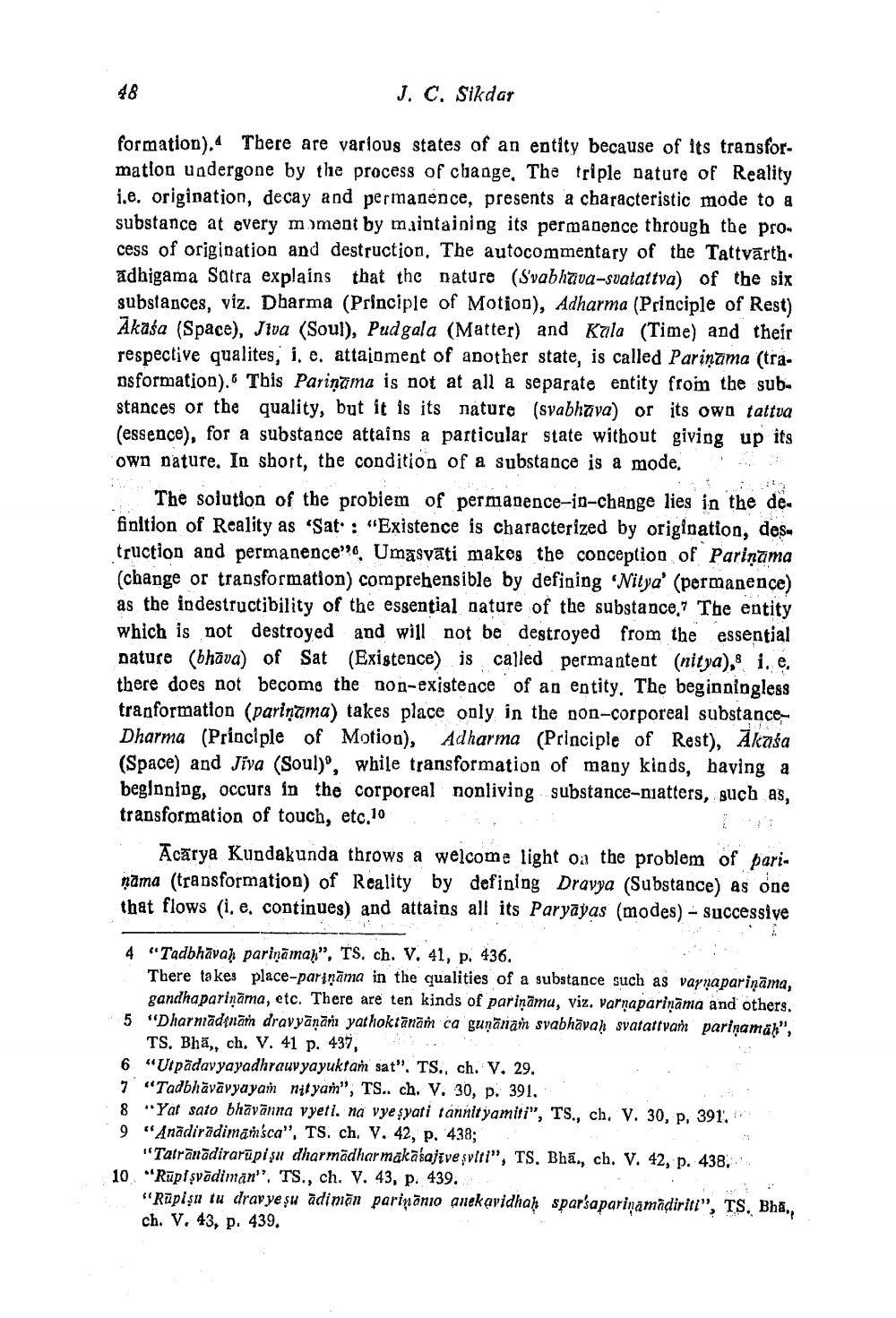________________
J. C. Sikdar
formation). There are various states of an entity because of its transformation undergone by the process of change. The triple nature of Reality i.e. origination, decay and permanence, presents a characteristic mode to a substance at every mment by maintaining its permanence through the process of origination and destruction. The autocommentary of the Tattvārth. adhigama Satra explains that the nature (S'vabhava-svatattva) of the six substances, viz. Dharma (Principle of Motion), Adharma (Principle of Rest) Akasa (Space), Jiva (Soul), Pudgala (Matter) and Kala (Time) and their respective qualites, i, e. attainment of another state, is called Pariņāma (transformation). This Pariņāma is not at all a separate entity from the substances or the quality, but it is its nature (svabhava) or its own tattva (essence), for a substance attains a particular state without giving up its own nature. In short, the condition of a substance is a mode,
The solution of the probiem of permanence-in-change lies in the definition of Reality as 'Sat: "Existence is characterized by origination, des truction and permanence!?, Umasvāti makes the conception of Pariņāma (change or transformation) comprehensible by defining Nitya' (permanence) as the indestructibility of the essential nature of the substance. The entity which is not destroyed and will not be destroyed from the essential nature (bhāva) of Sat (Existence) is called permantent (nitya), i.e. there does not become the non-existence of an entity. The beginningless tranformation (pariņāma) takes place only in the non-corporeal substanceDharma (Principle of Motion), Adharma (Principle of Rest), Akaša (Space) and Jiva (Soul), while transformation of many kinds, baying a beginning, occurs in the corporeal nonliving substance-niatters, such as, transformation of touch, etc.10
Acārya Kundakunda throws a welcome light oa the problem of pariņāma (transformation) of Reality by defining Dravya (Substance) as one that flows (i. e, continues) and attains all its Paryayas (modes) – successive
4 "Tadbhāvaḥ pariņāmaḥ”, TS. ch. V. 41, p. 436.
There takes place-pariņāma in the qualities of a substance such as varnapariņāma,
gandhapariņāma, etc. There are ten kinds of pariņāmu, viz. Varnaparināma and others. 5 "Dharmādınärn dravyāņārı yathokrānāṁ ca gunānam svabhāvaḥ svatattvam pariņamät",
TS. Bhā,, ch. V. 41 p. 437, 6 “Utpadavyayadhrauvyayuktan sat". TS., ch. V. 29. 7 “Tadbhāvāvyayam nityan", TS.. ch. V. 30, p. 391, 8 "Yat sato bhāvānna vyeti, na vye syati tannltyamiti", Ts., ch. V. 30, p. 391. 9 "Anădiradimansca", TS. ch. V. 42, p. 438;
"Tatrānādirarūpişu dharmādharmakašajtve şviti", TS, Bhā., ch. V. 42, p. 438. 10. "Rūpişvõdiman'' TS., ch. V. 43, p. 439.
“Rūpişu tu dravye şu ādimãn paripānio anekavidhah sparsaparināmādiriti", TS, Bha, ch. V. 43, p. 439.




